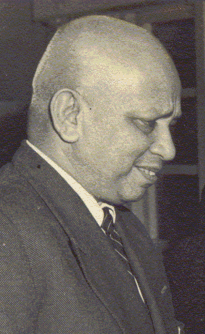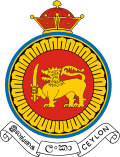Governor-General of Ceylon
| Governor-general of Ceylon | |
|---|---|
|
Coat of Arms of the Dominion of Ceylon | |
| Style | Excellency |
| Residence | Queen's House |
| Appointer | Monarch of Ceylon |
| Precursor | Governor of British Ceylon |
| Formation | 4 February 1948 |
| First holder | Henry Monck-Mason Moore |
| Final holder | William Gopallawa |
| Abolished | 22 May 1972 |
| Succession | President of Sri Lanka |
| Salary | £8,000 a year |
The governor-general of Ceylon was the representative of the Ceylonese monarch and head of state, who held the title of King or Queen of Ceylon (as of 1952, Queen Elizabeth II) from 1948 when the country became independent as a Dominion until it became the republic of Sri Lanka in 1972.[1]
Role
The monarch, on the advice of the Prime Minister, appointed a governor-general to be his/her representative in Ceylon. Neither the monarch nor the Governor-General had any real authority in conducting the administration of the country (however, both possessed reserve powers under the constitution which would allow them full control of the nation's governance whenever in their opinion a case of emergency requiring such action arises). Real legislative and executive responsibilities rested with the elected representatives of the people. During several periods when a state of emergency was declared the Governor-General used his reserved powers.
The governor-general represented the monarch on ceremonial occasions such as the opening of Parliament, the presentation of honours and military parades. Under the Constitution, he was given authority to act in some matters, for example in appointing and disciplining officers of the civil service, in proroguing Parliament and so on, but only in a few cases was he empowered to act entirely on his own discretion. When the Monarch was present in Ceylon on official visits, the post of Governor-General ceased to exist during the said period. On the absence of the governor-general, the Chief Justice of Ceylon became acting Governor-General.
History
There were four governors-general who represented the Ceylonese monarch.
Sir Henry Monck-Mason Moore became the last Governor of Ceylon and first governor-general when the Ceylon Order in Council, the first constitution of independent Ceylon came into effect. He was followed by Lord Soulbury, thereafter by Sir Oliver Goonetilleke the first Ceylonese to be appointed to the post. When William Gopallawa was appointed as Governor-General in 1962, he discarded the ceremonial uniform of office.
When Ceylon became a republic in 1972 the post was replaced by the office of President of Sri Lanka.
Residence
The official residence and office of the governor-general was the Queen's House (currently the President's House) in Colombo. Other Governor-General residences include:
- the Queen's Pavilion, in Kandy, was the residences used for (rare) state functions;
- the Queen's Cottage was the vacationing residence in the town of Nuwara Eliya.
Governors-general of Ceylon
| Portrait | Name | Birth | Death | Governor-General From | Governor-General Until | Sovereign |
|---|---|---|---|---|---|---|
 | Sir Henry Monck-Mason Moore, GCMG, KStJ | 1887 | 1964 | 4 February 1948 | 6 July 1949 | George VI |
 | Herwald Ramsbotham, 1st Viscount Soulbury, GCMG, GCVO, OBE, MC, PC | 6 March 1887 | 30 January 1971 | 6 July 1949 | 17 July 1954 | George VI Elizabeth II |
 | Sir Oliver Ernest Goonetilleke, GCMG, KCVO, KBE | 20 October 1892 | 17 December 1978 | 17 July 1954 | 2 March 1962 | Elizabeth II |
 | William Gopallawa, MBE | 17 September 1897 | 31 January 1981 | 2 March 1962 | 22 May 1972 | Elizabeth II |
- Acting Governors-general
| Portrait | Name | Birth | Death | Governor-General From | Governor-General Until | Sovereign |
|---|---|---|---|---|---|---|
 | Acting Justice Arthur Wijewardena | 21 March 1887 | 1964 | 195? | 195? | Elizabeth II |
 | Acting Justice C. Nagalingam, KC | 25 October 1893 | 25 October 1958 | 1954 | 1954 | Elizabeth II |
Flag of the governor-general
|
|
See also
References
- ↑ V "Ceylon Constitution Order in Council 1946" Check
|url=value (help). Tamilnation. Retrieved 9 November 2012.

.svg.png)
.svg.png)

